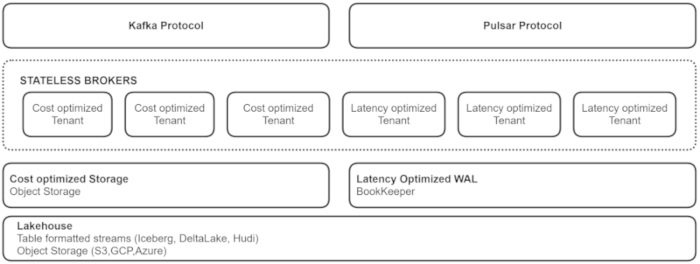In the realm of data streaming platforms, StreamNative’s Ursa architecture represents a transformative shift, particularly with its “Lakehouse First” design. This blog post explores the technical underpinnings of this approach, its advantages, and the impact it has on data handling and processing.
What is a Lakehouse?
Before looking into Ursas architecture, it’s essential to understand the concept of a “lakehouse.” A lakehouse combines the best elements of data lakes and data warehouses, aiming to provide the vast data handling capabilities of a lake with the performance and management features of a warehouse. It supports both structured and unstructured data, offering efficient data querying capabilities.
Ursa’s Lakehouse Integration
Ursa architecture by StreamNative leverages this lakehouse concept by streaming structured data directly into the lakehouse, eliminating the need for separate storage and processing layers. This integration facilitates real-time data availability for querying and analytics, significantly reducing the latency that typically comes with batch processing systems.
Key Components and Workflow
-
Data Ingestion: Ursa ingests data through various connectors that can interface with existing data generation sources, maintaining compatibility with Kafka APIs to ensure seamless migration from existing Kafka-based systems.
-
Data Management: Upon ingestion, data is immediately formatted into lakehouse-compatible formats. This is crucial for enabling real-time analytics and querying capabilities without the need for data transformation or schema management processes that traditional architectures require.
-
Storage Optimization: Ursa employs mechanisms like data compaction and partitioning to optimize storage in the lakehouse. This not only enhances query performance but also reduces storage costs by eliminating redundant data storage and minimizing the data footprint.
Architectural Diagram

Figure 1: Simplified diagram of Ursa’s integration with a lakehouse architecture.
Benefits of Ursa’s Lakehouse First Architecture
-
Real-time Data Availability: Data streamed into Ursa is instantly available in the lakehouse, enabling real-time analytics and decision-making capabilities.
-
Cost Efficiency: By reducing the redundancy in data storage and streamlining data management processes, Ursa significantly lowers the total cost of ownership compared to traditional data architectures.
-
Scalability: Ursa’s design is inherently scalable, benefiting from the underlying cloud-native features of lakehouses such as dynamic resource allocation and horizontal scaling.
-
Simplified Management: The elimination of complex data tiering simplifies the data architecture, reducing the administrative overhead associated with data lifecycle management.
Use Cases
-
Real-Time Analytics: Companies can perform analytics on real-time data for instant insights, which is crucial for industries like finance and e-commerce where timely data is critical.
-
Machine Learning: Instant access to data enhances the capabilities of machine learning models to train on the most recent data, improving accuracy and performance.
Conclusion
Ursa’s Lakehouse First architecture is not just a technical advancement but a strategic enhancement that aligns with the modern demands of data-intensive applications. By integrating directly with lakehouses, Ursa allows organizations to leverage their data more effectively, driving insights and value creation at unprecedented speeds.
This exploration of Ursa’s architecture illustrates how it stands poised to redefine the data streaming landscape, combining efficiency with robust scalability and performance.